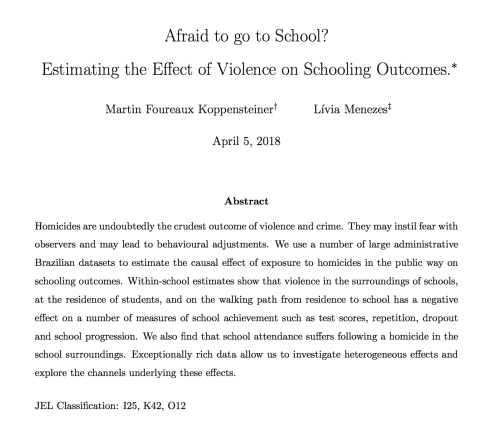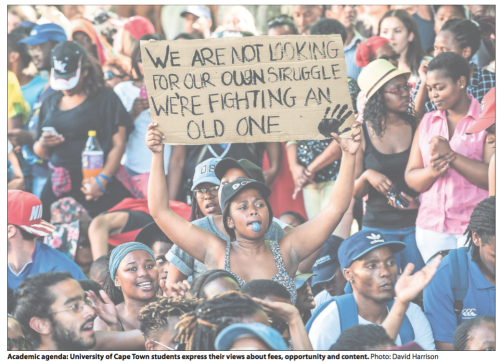
In the past three months South African higher education has come into full focus thanks to efforts of students in #FeesMustFall, #OpenStellies, #RhodesMustFall and others. The article below was written by one of RESEP’s researchers, Dr Martin Gustafsson, and first appeared in Business Leadership South Africa’s newsletter. I’ve highlighted the sections I think are most important to note…
Higher Education Policy Challenges – Dr Martin Gustafsson
“I recall a prominent person from organised business declaring some years back at a meeting that the business sector in South Africa had essentially withdrawn from the education policy discourse to avoid conflict with government. Instead, the sector had turned its attention to easier, less controversial areas of involvement, such as partnerships with individual education institutions and bursaries for promising students. This is not a good approach. Smaller projects can make a difference, but policy matters and it is something to which business should pay more attention. Business is well placed to provide policy advice in areas where it is strong: unit costs, cost-effectiveness, trade-offs between priorities and efficient management.
What are some of the difficult policy questions in what has recently become a volatile higher education sector?
Low public spending on higher education has been in the spotlight. This spending comes to 0.6% of GDP, compared to around 1.1% for comparable countries. The problem relates more to low student numbers than low spending per student. If we use countries at South Africa’s level of development as our benchmark, UNESCO education statistics suggest that our public spending per student should be 12% higher, while the number of students should increase by 30%. Current pressures to spend more per student are justified, but this should not be allowed to slow down the growth we have been seeing in enrolments.
Of course growing the sector is not just about enrolling more students, but also about a higher ratio of graduates to enrolments. What in South Africa is referred to as low ‘throughput rates’ – essentially high levels of dropping out and repetition – are commonly considered a core problem. We would be in a better position to respond to this problem if we understood it better.
Low throughput rates are not a peculiarly South African phenomenon. Similar patterns are found in many countries, which suggests that shifting the numbers is not easy. An Organisation for Economic Co-operation and Development (OECD) report on dropping out at tertiary level indicates that around 53% of students enrolling for a degree in the United States do not attain the degree. The Council for Higher Education has found the figure to be a rather similar 55% in South Africa. For the OECD as a whole, however, the figure is a better 31%. My own analysis of household data suggests that the ratio of degrees obtained per year to the number of full-time equivalent students, the graduation rate is around 1:7 for South Africa and Brazil.
So what are the circumstances of around half of our university students who do not complete a degree? It is difficult to obtain an overall picture. Sample-based household surveys, such as Stats SA’s Labour Force Survey are of limited use partly because the students in question are a small percentage of the population, and because there are no questions relating to tertiary-level dropping out. Longitudinal surveys conducted by universities or faculties can tell us a bit, though they do not provide a national picture. By far the most commonly cited reason for dropping out is financial constraints. However, students’ academic results and their ability to find funding are closely linked. If their results are poor, it is more difficult to renew funding. Yet the data we have indicates that the tragedy of academically well-performing students who drop out mainly due to funding reasons is substantial. It is a tragedy for the individual, but also for the country’s development, given the skills shortfall in the labour market, and it is bad for the attainment of workplace equity targets.
The OECD report warns against an all-or-nothing approach of classifying all drop-outs as failures and a manifestation of wasted effort. Even an incomplete university education is likely to improve an individual’s wage prospects and productivity in the workplace. It is in the interests of business to advocate for and fund more rigorous research on, for instance, the relationship between wages and the actual range of higher education outcomes which includes non-completed graduates.
The policy debates should be informed by accurate estimates, which exist, of the graduate unemployment rate. This rate is relatively low, and lower than what is suggested by some figures which have been quoted, including figures from an inaccurate January 2012 article in The Economist.
An unfortunate blind spot in our strategies for expanding the university sector is the lack of attention paid to the role of private universities. Countries such as China and Brazil, which have expanded their university enrolments even faster than South Africa, have succeeded in doing so partly through carefully thought out policies governing the emergence of more private universities. Such universities need not be elite relative to public universities, and there are ways of dealing with the risk of sub-standard educational quality offered by unscrupulous institutions.
Brazil’s strategy for combatting low-quality private universities and poor quality higher education at public institutions, is unusual and fascinating. Final year undergraduate students must write, apart from examinations set by the university, a short discipline-specific nationally standardised test which allows the national authorities to gauge which universities are clearly not teaching their students the basics. Moreover, aggregate test results are publicly available, putting students and their families in a more informed position when they select a university. Marcelo Rezende, in an article in Economics of Education Review, argued that the system has helped universities to focus on producing quality graduates.
Two institutions other than the universities are critical for building a better higher education system. Problems in the National Student Financial Aid Scheme are at the core of the 2015 unrest in the sector. The recommendations of the official 2010 review report remain relevant today. Secondly, without further educational quality improvements in the schooling system, the expansion of universities will be difficult. The National Development Plan’s key strategy for improving schools, paying attention to school principals – specifically their hiring, functions, remuneration and performance contracts – is a sensible one.
//
On the issue of school principals I would strongly recommend following the work of Gabrielle Wills, a PhD student at RESEP who has done some very innovative and useful research on principals and leadership in South Africa. For example see her 2015 Working Paper “A profile of the labour market for school principals in South Africa” which she presented at a conference earlier this year (PPT here).















